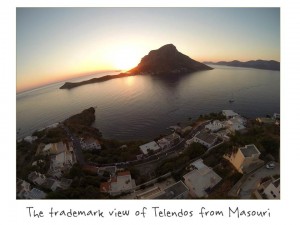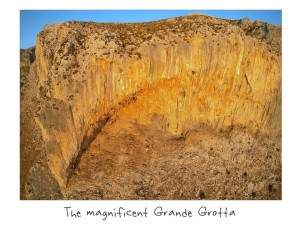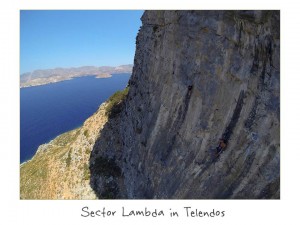
One thing you know for sure when climbing in Kalymnos is that you will meet fun, interesting people from all over the world. Two of the awesome climbers we met for the first time this summer (though they’ve been here before) are Max Nanao and Chloe Zubieta. Besides their good company, we also enjoyed a little gadget they brought along called the Phantom: a small radio-controlled helicopter with a GoPro camera, which they used to film and photograph Kalymnos from the air. The results are fantastic, in our opinion, as all these familiar sights are fascinating viewed from an entirely different angle. Naturally, it takes skill to operate a device like this and there are some safety considerations as well, so Max has kindly provided us with more info from his experience below. A big thank you to Max and Chloe, and see you again next time (November, was it?)

Max Nanao says:
“I’ve been fascinated by aerial photography for as long as I can remember. I would imagine that others with photographic inclinations have probably had similar experiences to mine: gazing at photos taken from airplanes or even spacecraft and wondering what it would be like to be behind the lens. Unfortunately, the stars never aligned for me to be able to take photos from a plane, helicopter or space shuttle except for the odd blurry shot taken from a commercial jet window.
Fast forward to a few months ago though, when I discovered that multirotor radio controlled helicopters with enough payload for a small camera had come down  from the “ridiculously expensive” price category to the “too expensive” category — hooray! I couldn’t help but buy a newly released quad-rotor from a company called DJI called the Phantom and start experimenting.
from the “ridiculously expensive” price category to the “too expensive” category — hooray! I couldn’t help but buy a newly released quad-rotor from a company called DJI called the Phantom and start experimenting.
My first flight ended somewhat unceremoniously with a low speed crash into a stand of stinging nettles, but after several more such close encounters with the ground and countless flights (flight times are around 10-12 minutes from the 2200 mAh lithium polymer battery so accumulating flight time takes a while), I acquired a reasonable amount of skill and confidence. Enough so that I hiked to the top of a local mountain called the Chamchaude and then to some local climbing areas like Tina Dalle. Except for the occasional moments of terror when the Phantom would move in unexpected directions, it went well.

There was of course no question of whether I would bring it with me to Kalymnos, on our most recent trip to the island. I partially disassembled the Phantom, packed it in my carry-on bag, and happily there were no problems with security. Once on Kalymnos, I re-assembled the helicopter and transported it from crag to crag by strapping it to accessory loops on my backpack with a bungee cord. Over the eleven days that we were on the island, I was almost giddy with the shots and footage that I was getting. Despite the limitations of the GoPro camera, which include relatively low pixel count, marginal optics, no RAW file generation and no way to turn off sharpening, I was absolutely thrilled with the new and unique perspective.
Below is a video from our trip. Please excuse the slightly cheesy soundtrack!
_________________________________________________________________________________________

Some tips and tricks
+Battery life is short. The Phantom gives you visual feedback when the battery is low, but when possible I also start a timer on my phone.
+The Phantom has a GPS assisted mode, which will stop it in the absence of command from the controller. I made extensive use of this mode when learning to fly. Unfortunately, it can make video shakier than in the unassisted mode.
+Wind can be very problematic. At a minimum, without a stabilization device like a gimbal, you will not get smooth video in windy conditions.  You can of course still shoot still images, but my preference is to avoid flying in any kind of wind. Landing/Takeoff in particular are a lot more difficult.
You can of course still shoot still images, but my preference is to avoid flying in any kind of wind. Landing/Takeoff in particular are a lot more difficult.
+Make sure you do not have your GoPro in wifi mode! It can interfere with the radio control of the Phantom. I do however use the GoPro app before flying to confirm tha no part of the Phantom is in frame. The legs and props are the most common items to find in your shots.
+Extra batteries are relatively inexpensive, but very handy.
A word about safety
As climbers, we are frequently one mistake away from a serious accident, so we are used to thinking about safety. The situation gets more complicated however, when you add a multirotor to the mix. Although I have not tested the result of the propellers hitting a climbing rope, I imagine that it would not be good. It’s the same story for propellers vs. climber — Simply put, the propellers are dangerous. Therefore, one needs to exercise extreme caution when filming climbers, and consider using propeller guards like these if the multirotor does not already have them built in. Special care should be taken when there are children around, since multirotors look like toys. Make kids and their parents aware of the danger and have them stand well away.
Etiquette
Although response to the quadrotor by climbers has been universally enthusiastic, ask the climbers beforehand if they would like to be photographed. In addition to the safety issues mentioned above, multirotors can be loud and potentially unnerving.
Laws and Insurance
Check your local laws on the legality of flying a multirotor. There are usually restrictions on where you can fly. You might also be required to have insurance.”
All photos and video by Max Nanao



2 Comments
According to this web site, new rules for 2017 for drones:
https://drone-traveller.com/drone-laws-greece/
You can’t fly drones within 8km of an airport, which pretty much eliminates flying on most Greek islands. On Kalymnos, this eliminates drone usage on all cliffs except those beyond Skalia (like Secret Garden, Sakati Cave, etc).
Great!